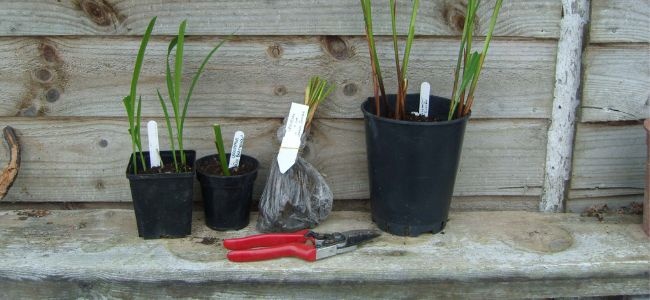-
0
Your Shopping Basket
0 ITEMS IN YOUR BASKET

Crocosmia Growing Tips
 Background
Background Crocosmia are superb summer flowering bulbs, originating mostly from South Africa, and flowering in fiery tones of orange, yellow and red. In the wild, they grow in a variety of places, from high mountain-sides, alongside streams and in shaded woodland. They grow where there is a good supply of moisture during the growing season but prefer drainage during the winter.
They are not true bulbs, but 'corms', which is a modified swollen stem. Each year a fresh corm is formed on top of the old one, and this new corm will produce next years flowers. The old corms persist and act as a storage organ to support the top one, so the corms gradually form 'chains' below the soil. They increase by forming creeping rhizomes below the soil, fresh corms appear at the end of a rhizome.
They are hardy to around -5°C however we grow them in borders where the air temperature has fallen to -9°C and lower. Plants in the border will be insulated by the soil, and a mulch of bark will act like a duvet. But plants in pots are best brought into a cold greenhouse or porch over the winter.
Crocosmia are wind and salt tolerant – and they are mostly (but not completely) left alone by rabbits and deer!!
There are many hybrids to choose from, as well as the species from the wild. Flowering heights can vary from 60cm (2ft) to over 1.5m (5ft), and different forms can bloom as early as late June to late September (with one April/May flowering species - Crocosmia fucata).
Bees and hoverflies find the open flowers attractive to feed from.
Growing Position
Crocosmia prefer well-drained soil and at at least half a day in the sun. Varieties with larger downward-facing flowers are usually related to the wild woodland-dwelling Crocosmia aurea and they tend to perform better even if they are in part shade.
They combine well with grasses, taller spring bulbs (such as Alliums which flower amongst the emerging Crocosmia leaves), and perennials such as Coreopsis, Kniphofia, Verbena bonariensis and Heleniums.
Crocosmia can also be grown in larger patio containers however, feed them well and split the clumps every 2 years. Protect pots in winter as they are more exposed to the cold.
Planting
Our pot-grown Crocosmia can be planted directly into the border – dig a 25cm (10”) deep hole and add grit to the base of the hole if drainage is poor). Plant with the corms set at around 12cm (5") deep incorporating some general purpose organic food and well rotted compost in the soil. Once planted, ideally apply a 5cm (2”) layer of mulch to the surface of the soil to retain moisture in summer and protect from cold in winter.
If your border is not ready, or the conditions are too cold or wet, keep your pots frost free until you are ready to plant. But if there is likely to be a long delay (more than 6 weeks), we suggest that pot your Crocosmia into 12.5cm (5") pots until you are ready.
Occasionally the leaves brown at the tips after planting - this is due to root disturbance and the plants will soon recover – it will not affect the long term establishment of your plants.
Aftercare
You will be pleased to know that Crocosmia are reliable plants and they do not require much care. Stakes are not necessary even in windy gardens, although some varieties such as Lucifer tend to arch to the side (if needed, use supports to hold such clumps upright, I usually don't bother myself unless they block a pathway or smother a neighbouring plant).
In autumn, it is good practice to apply a mulch of bark over the crown of the plant. I tend to cut the leaves back in late Autumn but not the full way as the old leaf stalks offer the corms added protection from winter cold. I pull these stalks away in early spring being careful not to damage any new shoots.
Clumps are best divided every 3 years or so in late Autumn or early Spring - this helps to maintain vigour and flowering. When you replant the divided clumps, plant more deeply as the corms tend to work their way to the surface over the years. As discussed earlier, the corms form 'chains' - all corms are viable but it's the ones at the top of the chain that will produce flowers.
Feed clumps with a handful of bonemeal, or slow release fertiliser each spring. Plants in pots will also benefit from liquid feed every two weeks or so in the growing season. Crocosmia do respond well to feeding and will reward you with extra blooms.
ENJOY YOUR CROCOSMIA!




